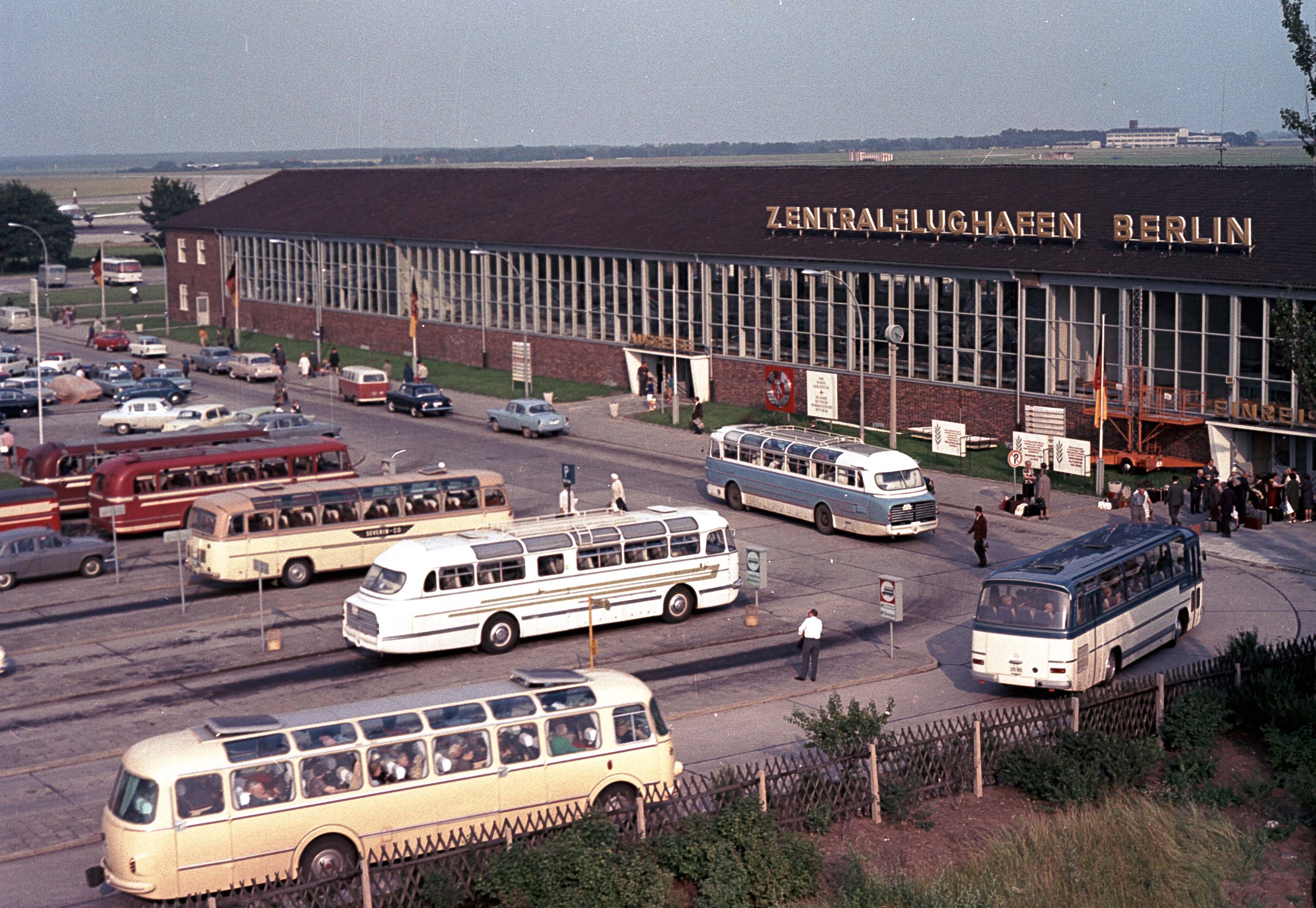
2022 |
The Supervisory Board decided on 18 November 2022 not to put Terminal 5 back into operation given the fact that concentrating air traffic in the midfield is the best way to organise operations for passengers and partners at the airport and the way favoured by everyone. Therefore, FBB is already implementing the single-roof concept laid out in the planning permission. |
2021 |
On 23 February, Flughafen Berlin Brandenburg GmbH will temporarily close BER's Terminal 5. Due to the Corona pandemic, passenger numbers have fallen very sharply worldwide. As a result, the expected traffic volume can be handled entirely at Terminal 1 until further notice. |
2020 |
Just before the commissioning of Berlin Brandenburg Airport Schönefeld Airport has become BER Terminal 5 (T5 for short). To avoid duplicate names of terminal areas, gates and parking spaces at BER, Schönefeld Airport’s building and parking infra-structure was already renamed for the summer flight schedule at the end of March: the terminal areas formerly known as A, B, C, D are now called K, L, Q, M. |
2019 |
Around 11.4 million passengers took off and landed at Schönefeld. With a view to continued operation as BER Terminal 5, work continued on service quality. From January 2019, Pier 3a, a section of Terminal A, was refurbished. The aim was to optimise operational processes, make better use of structural resources and simultaneously offer passengers a significantly higher quality of stay. |
2018 |
Around 12.7 million passengers flew via Schönefeld Airport. At the end of Novem-ber, a temporary waiting hall was built to ensure the necessary capacity during the refurbishment of Pier 3a at Terminal A (now K), which was planned for 2019. The building with an area of 2,600 m² and five gates is equipped for around 1,000 pas-sengers and can be reached directly from Terminal A via a passenger boarding bridge. |
2017 |
Continued rapid growth in Schönefeld: Compared to the previous year 2016, the number of passengers at SXF increased by 10.4% to 12.9 million. The aviation surfaces were further improved and expanded so that both locations could be operated in parallel with the opening of BER: It was, therefore, necessary to temporarily close the runway at Schönefeld Airport as part of construction work. Between July and October 2017 (as in 2015), air traffic was handled on BER’s future south runway. |
2016 |
Schönefeld Airport set a new record with its 10 millionth passenger. To provide the necessary capacity for the increasing passenger numbers, a new terminal was built in SXF North; the existing Terminal B was expanded and more parking spaces and a new long-distance bus station were created. |
2015 |
A total of more than 8.5 million passengers took off and landed at Schönefeld Air-port. The airport company renovated the runway at Schönefeld Airport from May to October, which would later become BER’s north runway. During the construction work, flight operations were temporarily handled via BER’s south runway. At the end of September, FBB set the course for the further expansion of air traffic infra-structure at Schönefeld. The Supervisory Board gave the green light for a EUR 65 million, which secured growth in traffic at Schönefeld until the opening of BER, en-abled the construction of the government airport and initiated the medium-term expansion of the site until 2023. |
2014 |
On 5 May 2014, easyJet and the airport company celebrated the airline’s ten-year anniversary at Schönefeld. The airline had carried a total of over 30 million passengers to and from Berlin. |
2013 |
The aviation areas were brought up to scratch, Terminal B (now terminal area K) was acclimatised to the increased passenger numbers and the bathroom facilities were completely refurbished. A total of 6,727,306 passengers were handled there. |
2011 |
The Potsdam Ministry of Transport approved the application for the new govern-ment airport at Schönefeld. The aircraft fleet is parked there and foreign guests are received there. |
2010 |
The airport in the south of Berlin has awoken from its long slumber and emerges as Germany’s boom airport. By 2010, the number of passengers had risen continually to 7.3 million, meaning that Schönefeld has succeeded in almost quadrupling passenger figures within five years. Low-cost carriers account for more than 80 per cent of traffic at Schönefeld. Attractive destinations across Europe and low prices make Schönefeld appealing for tourists and business travellers alike. |
2005 |
Germanwings chooses Schönefeld as a base airport for two aircraft that fly to cities not covered by easyJet. |
2004 |
The arrival of easyJet increases the appeal of the airport for many passengers, as the British low-cost carrier flies nonstop to many destinations from Berlin-Schönefeld. |
2003 |
The airport, which was mainly used for charter flights during the 1990s, is increasingly used by low-cost airlines (Ryanair, V Bird, Germanwings). |
1996 |
Berlin, Brandenburg and the Federal Republic of Germany jointly agree to build an international airport for Berlin and Brandenburg (BBI). The designated site is Schoenefeld Airport, which is to be significantly enlarged. |
1995 |
The expansion of Terminal A (now terminal section L) is agreed. |
1993 |
Jetways are built at Terminal A (now terminal section L). Passengers previously had to walk to the aircraft. |
1991 |
Between 1991 and 1993 the airport is used as a base for the federal air force’s No. 65 air transport squadron. |
1991 |
Interflug is closed down after German reunification. Passenger numbers at the airport drop dramatically. |
1989 |
Another air accident occurs in Schönefeld. The rudder of an aircraft jams and the plane crashes onto a field behind the runway, killing 22 of the 113 passengers. |
1986 |
The second-worst air accident in the history of East Germany occurs: 72 people die, including 20 school children. |
1985 |
The airport is extended by the addition of the buildings later named Terminal B and C (now terminal section K and Q). |
1976 |
The future Terminal A (now terminal section L) opens as NPA (New Passenger Handling). |
1969 |
The airport handles more than one million passengers per year. |
1963 |
A bus line starts operating between Charlottenburg (West Berlin) and Schönefeld Airport. |
1960 |
The airport is widely used by West German passengers, who fly from here to destinations such as Prague and Budapest, which are not served by West German airports. |
1947 |
The Soviet military administration orders the construction of a civilian airport; the Russian airline Aeroflot starts commercial air services in Schoenefeld. As the site is outside the city’s boundaries, the East German airline Interflug can also take off and land here; the West German carrier Lufthansa is not permitted to operate at the inner-city airports Tempelhof and Tegel due to the Four Power Agreement. |
1946 |
At the end of May 1946, the Soviet airline Aeroflot started a scheduled service between Berlin Schönefeld and Moscow. |
1934 |
Construction of Henschel Flugzeug-Werke including airfield and three runways. Founded in 1934, the subsidiary of the Henschel & Sohn company from Kassel developed into one of the most important German armament factories for fighter planes and glide bombs during the National Socialist era. Aircraft, weapons and weapons systems were developed, tested and built in Schönefeld that brought death and destruction throughout Europe. So-called 'foreign workers' from the occupied territories, forced labourers, prisoners of war, women and girls from concentration camps had to produce supplies under inhumane conditions for the German extermination machinery that was destroying their own homeland. |

